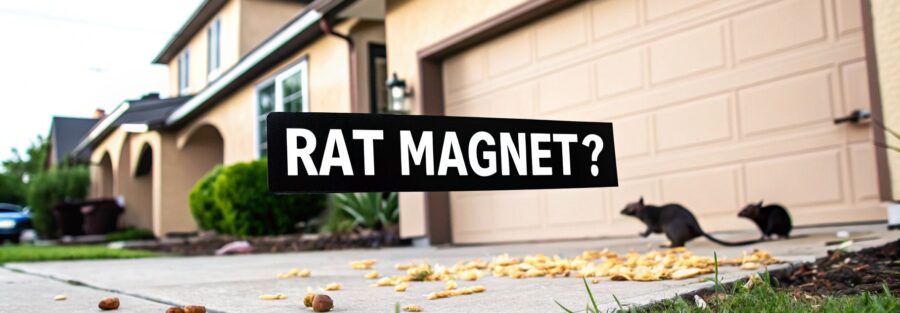When you boil it down, rats are after three very simple things: food, safe shelter, and easy access to water. Understanding what draws them in is the first and most critical step to preventing an infestation. The truth is, most of our homes unintentionally provide this perfect survival kit without us even realising it.
The Three Things That Make Your Home a Rat Magnet
Try to see your home from a rat's perspective for a moment. It isn't just a building; it’s a potential five-star hotel, offering everything they need not just to survive, but to thrive.
The real key to rat prevention isn’t about fighting an invasion after it’s already begun. It’s about making your property an inconvenient, unattractive place for them to visit in the first place. If you can systematically remove their primary motivators, you’re effectively closing your doors to these unwelcome guests for good.
The scale of the problem here in the UK is staggering. With an estimated rat population soaring past 150 million—more than double the human population—the competition for resources is fierce. Urban centres like London, Birmingham, and Glasgow have become hotspots because dense human activity provides a constant, reliable supply of food and shelter. You can learn more about the UK’s growing rat populations and why cities are so appealing to them.
The Survival Triangle: Food, Water, and Shelter
These three elements form what we in the industry call the "survival triangle," a concept that dictates almost all rat behaviour. If your property offers even one of these, you’re on their radar. If it offers all three, an infestation becomes almost inevitable.
Your goal is to break this triangle by taking away each component.
- Food: This is by far the most powerful lure. Rats are opportunistic omnivores and will eat just about anything, from pet food left in a bowl overnight to fallen fruit in the garden or scraps in a poorly sealed bin.
- Shelter: They need a secure, dark place to nest where they feel safe from predators and the elements. Cluttered sheds, forgotten corners of the loft, wall cavities, and overgrown vegetation are all prime real estate for them.
- Water: A consistent water source is non-negotiable. Something as simple as a leaky outdoor tap, a pet’s water bowl, or even chronically clogged gutters can provide all the hydration they need to survive and breed.
This infographic neatly shows the simple hierarchy of what brings rats onto any property.
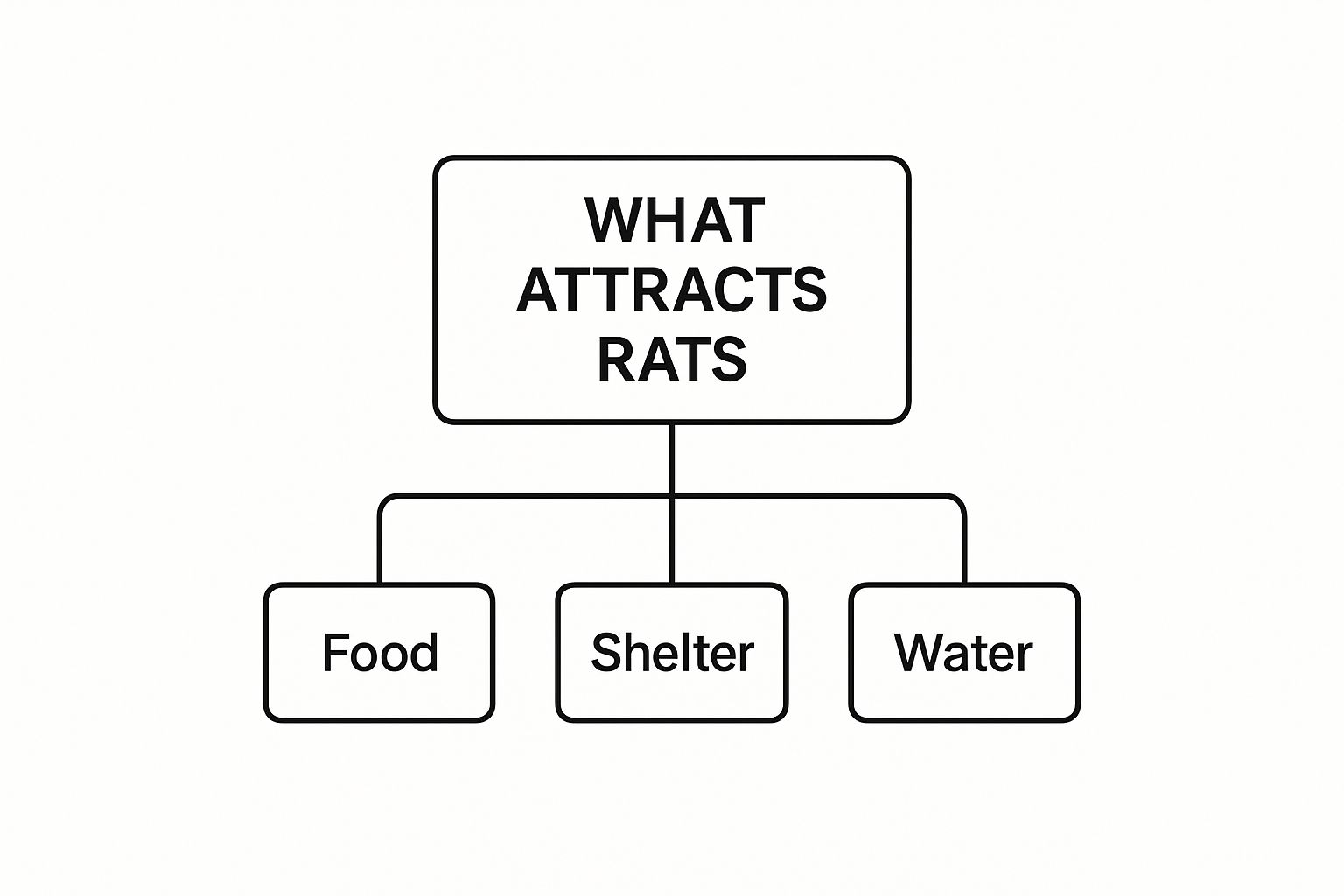
As you can see, these three core needs—food, shelter, and water—are the foundational pillars of any rat problem. Getting a handle on them is the key to effective, long-term prevention.
Primary Rat Attractants at a Glance
To make it even clearer, here’s a quick breakdown of the most common things that turn a property into a rat magnet.
| Attractant Category | Specific Examples | Why It Attracts Rats |
|---|---|---|
| Food Sources | Unsealed bins, pet food left out, bird feeders, compost heaps, fallen fruit | Provides a reliable and easy-to-access source of nutrition for survival and breeding. |
| Shelter/Nesting | Clutter (log piles, sheds), overgrown gardens, wall cavities, decking, loft spaces | Offers a safe, warm, and dark place to hide from predators and raise young. |
| Water Access | Leaky pipes, pet water bowls, ponds, clogged gutters, dripping taps | Essential for hydration; a consistent water source allows a colony to thrive. |
By focusing on these specific areas, you can start to methodically "rat-proof" your home and garden, making it a far less appealing target for any passing rodents.
Your Home's 24/7 Buffet: How Food Sources Lure Rats
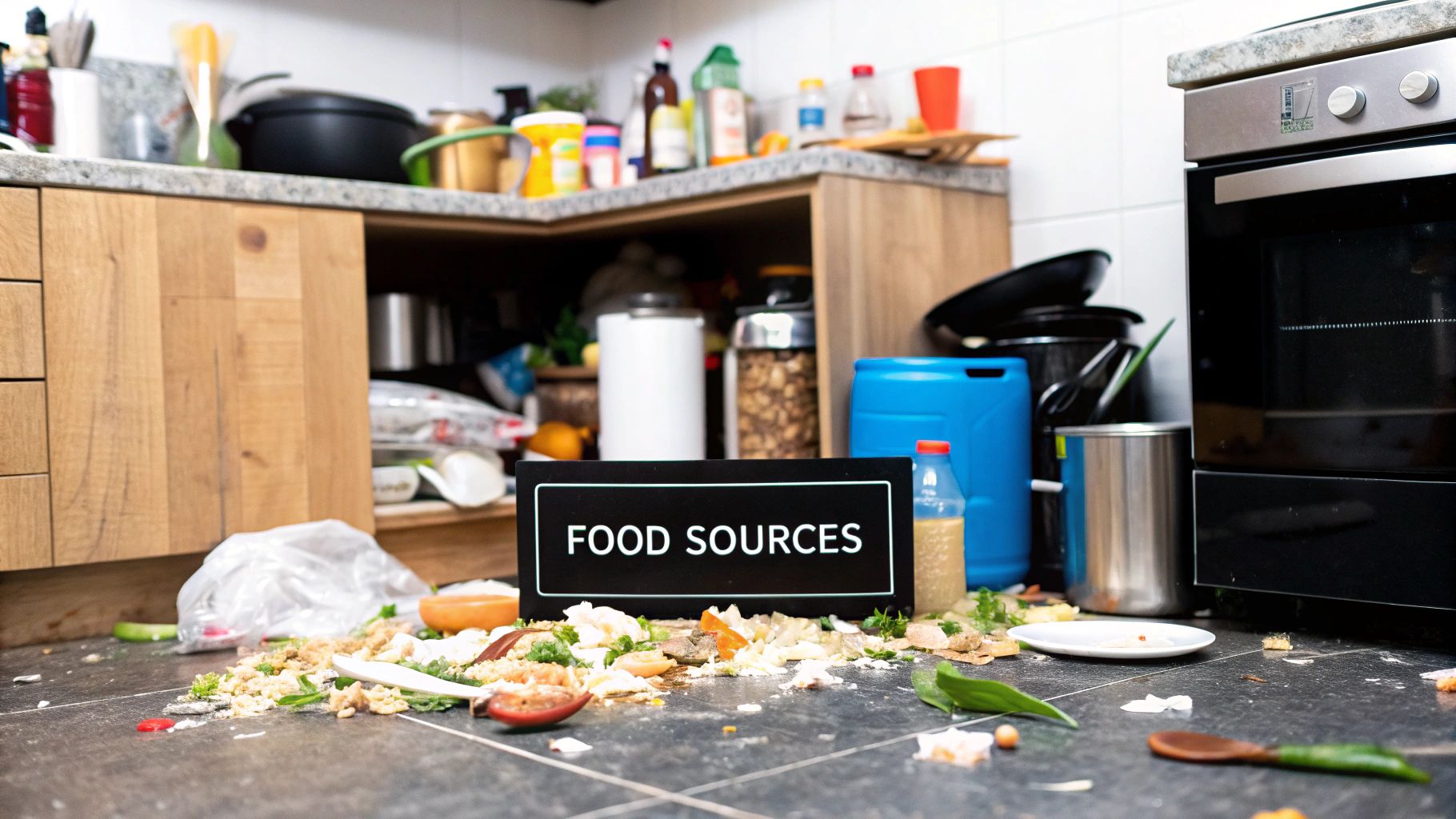
More than anything else, food is what draws rats to your property. It’s a powerful magnet, pulling them in with an almost gravitational force. You need to stop thinking of your home as just a building and start seeing it through their eyes: a potential all-you-can-eat buffet. Even a few crumbs can send a loud, clear signal to any passing rodent that your place is a reliable food source.
This "buffet" goes far beyond obvious kitchen scraps. A consistent supply of food is what turns a one-off visitor into a permanent, breeding resident. It's the key difference between a rat just passing through and a full-blown infestation taking root in your walls or garden.
The Hidden Menu You're Offering
Rats are anything but fussy eaters. Their survival hinges on being opportunistic, and they have an incredible sense of smell to guide them to their next meal. You might be shocked at what’s on their menu.
Common, and often overlooked, food sources include:
- Unsecured Pet Food: That bowl of dog or cat food left out overnight? It's like putting out a welcome mat. Its high-protein content is especially appealing.
- Bird Feeders: While you’re trying to help garden birds, the spilled seeds from feeders create a predictable ground-level feast for rodents.
- Fallen Fruit and Nuts: Fruit rotting on the lawn from apple or pear trees provides a sweet, easy-to-reach food supply.
- Poorly Stored Pantry Items: Rats can make short work of paper, cardboard, and thin plastic bags to get at grains, cereals, and other dried goods.
- Accessible Compost Heaps: An open or unturned compost pile is a warm, constantly replenishing source of organic matter that rats will happily burrow into.
A consistent food supply is the absolute core of any rat infestation. Remove the food, and you remove the primary reason for them to stay. It’s the single most effective preventative measure you can take.
Your Bins and Waste Management
How you manage your rubbish is a critical line of defence. For a rat, an overflowing bin or a thin plastic bag left by the back door is a treasure trove. They are drawn to the scent of decaying food, and once they find a reliable source, they’ll just keep coming back.
We saw just how important this was during the UK's first COVID-19 lockdown. Changes in our behaviour and disruptions to bin collections led to a staggering 120% spike in rodent-related pest control calls, simply because more food waste was available in residential areas.
To shut down these tempting food sources, make sure all rubbish is stored in sturdy, sealed containers—metal bins are best as rats can't chew through them. Don't forget about internal food waste, either. To get rid of lingering food odours and waste that attracts pests, it's vital to promptly deal with issues like needing professional garbage disposal repair services. By cleaning up spills and crumbs immediately, both inside and out, you can keep your home's "buffet" officially closed for business.
Finding the Perfect Hideout: Where Rats Build Nests
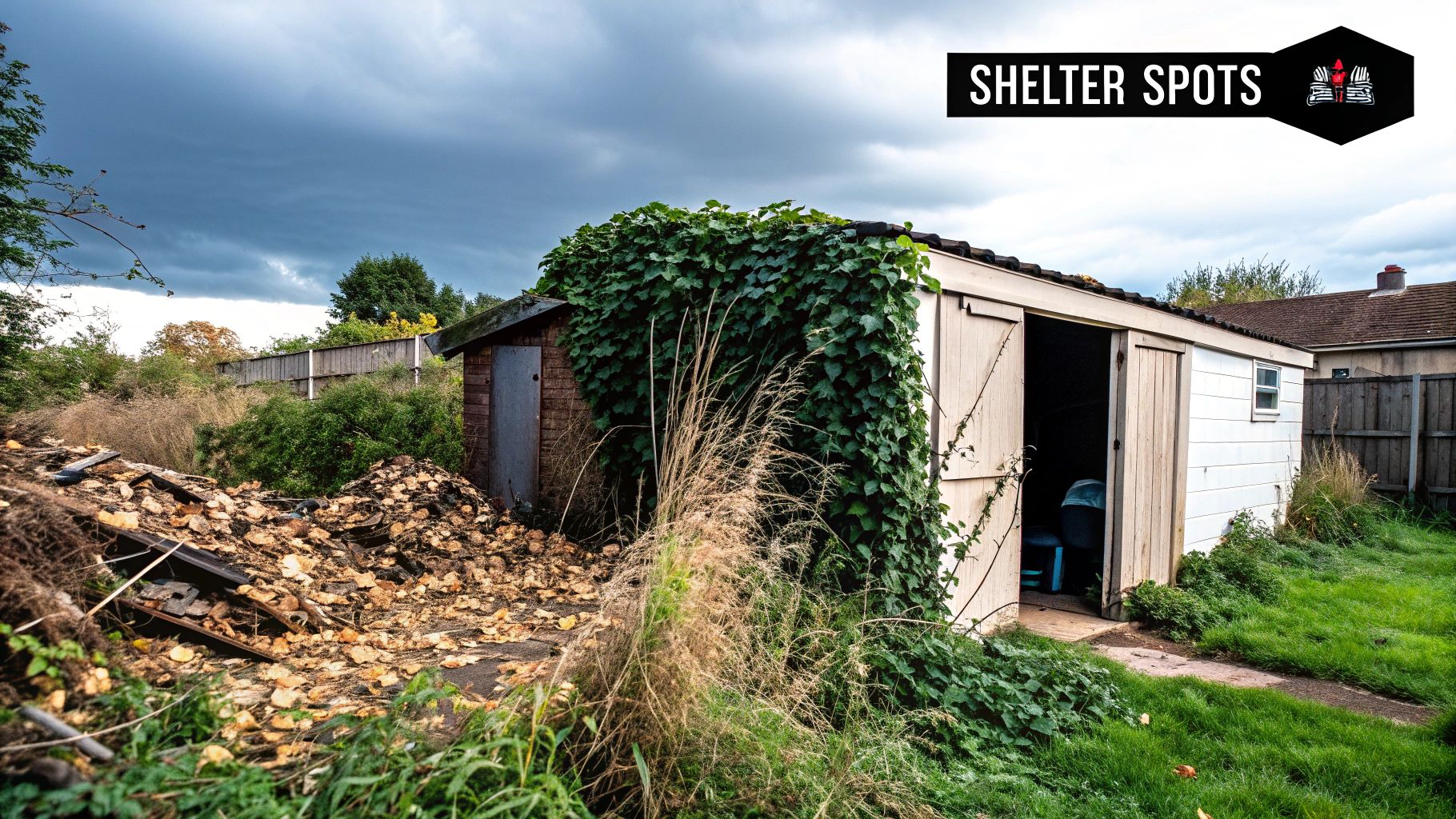
Once rats have locked down a reliable food source on your property, their focus immediately shifts. Next on the agenda is finding a safe, secure place to live and breed. It’s a bit like a property search from their perspective; they’re hunting for a quiet, dark, and undisturbed spot that offers solid protection from predators and the unpredictable British weather.
Your home and garden can offer a surprising number of five-star accommodations for a rodent family. And these aren’t random choices. Rats are hardwired to seek out specific conditions that guarantee safety and warmth for raising their young, which is why a messy shed or a forgotten corner of the loft is so much more than just clutter—to a rat, it's prime real estate.
Prime Real Estate for Rodents
Put simply, rats crave chaos and neglect. The areas of your property you rarely visit are the exact spots where they feel most comfortable setting up home. By getting wise to these high-risk zones, you can proactively make them completely inhospitable before a problem even starts.
Some of their absolute favourite spots include:
- Cluttered Sheds and Garages: Piles of old boxes, forgotten tools, and general clutter create a perfect labyrinth of hiding spots and ready-made nesting material.
- Overgrown Garden Corners: Dense vegetation, unturned compost heaps, and log piles provide excellent cover from prying eyes.
- Decking and Patios: The dark, sheltered void underneath decking is a classic rat haven. Dealing with rats under decking requires a specific approach to deny them this incredibly convenient shelter right next to your house.
- Lofts and Wall Cavities: These areas offer insulation—a ready-made source of warm bedding—and are almost completely free from human disturbance. A rat's dream.
A rat's ideal home is a place that is rarely disturbed, provides protection from the elements, and is located close to its primary food and water sources. Eliminating these sheltered spots is just as important as securing your bins.
The Building Blocks of a Rat's Nest
When it comes to building materials, rats are resourceful scavengers. They aren’t fussy. They will shred just about any soft, pliable material they can get their paws on to create a warm, comfortable nest for their pups. If you spot signs of this activity, it's a clear indicator that rats aren't just visiting for a snack—they're moving in.
They commonly use a mixture of scavenged items, including:
- Shredded paper and cardboard
- Loft insulation and fabric scraps
- Grass, twigs, and leaves from the garden
- Plastic bags and other soft rubbish
By keeping your property tidy and storing items in hard, sealed containers, you’re not just cleaning up; you're actively removing their building supplies. An organised shed, a well-managed compost pile, and sealed access points to lofts and walls will make your property far less appealing. You’re dismantling what attracts rats in the first place.
How Are Rats Getting Inside? Identifying the Entry Points
It’s a shocking fact, but a rat can flatten its body to squeeze through any gap it can get its head into. We're talking about a space no bigger than a 10p coin. This incredible flexibility means that seemingly tiny flaws in your home’s exterior are basically wide-open doorways for these pests. To really protect your property, you need to start thinking like a rat on a mission.
Their goal is simple: find the path of least resistance from the outside world into the warmth and safety of your home. These routes are often hidden in plain sight, created by a bit of wear and tear, an oversight during construction, or simple neglect. Once you know where to look, you can systematically seal these weak spots and turn your home into a fortress.
Mapping Out Their Favourite Routes
Rats are absolute masters of exploitation, and they will quickly find any weakness in your home's defences. Your property audit should focus on the places where different materials meet or where pipes and cables enter the building—these are almost always the first places to fail.
The most common access routes we see include:
- Gaps Around Pipes: Look closely where water, gas, and waste pipes enter your home. The holes drilled for them are often much larger than the pipe itself, leaving a perfect rat-sized gap that’s often left unsealed.
- Damaged Air Bricks: These are essential for ventilation, but a broken, crumbling, or unprotected air brick is a gift to a wandering rodent. Installing purpose-built protection like mesh air brick covers is a simple and highly effective way to secure these vulnerable points without blocking vital airflow.
- Foundation Flaws: Small cracks and holes in the foundation, especially in older properties, are incredibly common entry points that often go unnoticed.
- Roof and Eaves: Rats are surprisingly good climbers. Gaps under roof tiles, damaged soffits, or rotting fascia boards can grant them easy access straight into your loft.
It’s a common mistake to think rats only come in at ground level. They can easily scale rough walls, climb up drainpipes, and use overhanging trees to find entry points high up on a building. Never forget to check your roofline.
The Underground Highway System
While gaps in your walls and roof are a big deal, one of the most common—and most overlooked—entry routes is your drainage system. Many properties in the UK, particularly older ones from the Victorian era, are connected to drainage networks that act as underground highways for rats.
This network gives them warmth, shelter, and a direct, hidden path into buildings. In fact, between 2023 and mid-2025, the UK reported a staggering 518,240 rat infestations, with experts pointing to ageing drainage systems as a primary cause. Rats simply follow the scent of food waste from inside your kitchen, travelling through cracks or disused pipes to find their way in. You can read more about the UK's ongoing rat infestation challenges and their connection to drainage here.
Sealing these vulnerabilities is non-negotiable. Simple but effective materials like wire wool (which rats detest chewing) packed tightly into small gaps and then sealed over with cement or a strong filler can permanently block these entryways. A meticulous inspection and a bit of handiwork are often all it takes to close the door on these unwelcome intruders for good.
Understanding Your Neighbourhood's Rat Risk Factors
Sometimes, the real reason you have a rat problem isn't inside your four walls—it’s just outside them. While securing your own property is a vital first step, the surrounding environment plays an enormous role in your overall risk. You could have a perfectly sealed home and a spotless garden, but if your neighbourhood is a five-star resort for rats, you’ll always be fighting an uphill battle.
Think of it like living next to a busy motorway. Even with high fences, the constant flow of traffic means there's a higher chance someone eventually finds a way onto your property. It’s the same with rats. Nearby activities and community-wide issues can create a steady stream of rodents looking for new territories, and your home is a very tempting target. Understanding these external pressures is key to getting ahead of the problem.
How Construction and Development Stir the Pot
Have you ever noticed a sudden spike in rat sightings right after a nearby building was knocked down or a big construction project kicked off? It’s not your imagination. This is an incredibly common trigger for infestations. These projects don't magically create new rats; they just make hundreds of existing ones homeless.
When their established burrows and nests are dug up and destroyed, entire colonies are sent scattering in every direction. Suddenly, they're desperate and actively searching for the nearest available food, water, and shelter. Your property, which might have been completely off their radar before, can quickly become prime real estate for these displaced pests.
Construction and excavation work act like a pressure wave, pushing established rat populations outwards into new territories. Homes and businesses within a several-block radius of the site face a significantly higher risk of infestation during and immediately after the project.
Seasonal Shifts and Neighbourhood Hotspots
Rat behaviour changes dramatically with the seasons, creating predictable spikes in activity you can prepare for. As autumn rolls in and the temperature drops, rats launch a frantic search for warmth and a stable shelter to see them through the winter. This is precisely why so many people first notice scratching in the walls or droppings in the loft as the weather turns colder—rats are actively trying to move indoors.
On top of that, certain features within a neighbourhood can create permanent "hotspots" that act as breeding grounds and staging posts for infestations, putting everyone nearby at greater risk.
Key neighbourhood risk factors to look out for include:
- Proximity to Food Businesses: Restaurants, takeaways, and food processing plants are a goldmine for rats. Even with good intentions, the sheer volume of food waste can support huge populations if not managed perfectly.
- Poorly Maintained Communal Areas: Neglected parks, alleyways with overflowing bins, or messy communal waste areas are basically a public buffet and shelter for rodents.
- Waterways and Overgrowth: Rivers, canals, and overgrown railway embankments give rats everything they need. They offer a constant source of water and, crucially, covered travel corridors that allow them to move through a neighbourhood completely undetected.
Being aware of these external factors is crucial. It helps explain why even the most pristine home might still face a rat problem and shows why sometimes the solution isn't just about protecting your own space, but also about advocating for better maintenance and waste control across the whole community.
As the seasons change, so do the pressures from these local hotspots. Understanding this annual cycle is your best defence.
Here’s a quick guide to how rat behaviour shifts throughout the year and what you should be doing to stay one step ahead.
Seasonal Rat Activity and Prevention
| Season | Typical Rat Behaviour | Key Prevention Actions |
|---|---|---|
| Spring | Colonies expand rapidly. Young rats leave the nest to find new territories. They are actively foraging for food to support growing numbers. | Seal any new gaps that appeared over winter. Tidy the garden, removing clutter and potential nesting spots. Secure all food sources, including pet food and bird seed. |
| Summer | Outdoor activity is at its peak. Rats thrive in overgrown vegetation and take advantage of abundant natural food sources like fallen fruit and insects. | Keep gardens well-maintained and grass cut short. Clear away fallen fruit from trees promptly. Ensure all bins have tightly fitting lids. |
| Autumn | The "great migration" begins. As temperatures drop and outdoor food becomes scarce, rats actively seek warmth and shelter indoors. This is the highest-risk season for new infestations. | Conduct a thorough inspection of your property's exterior. Seal cracks in foundations, gaps around pipes, and repair damaged vents. Check lofts and garages for early signs of entry. |
| Winter | Rats that have successfully moved indoors will nest and breed, often in wall cavities, lofts, or under floorboards. Outdoor activity is minimal. | Be vigilant for indoor signs like droppings, gnaw marks, or scratching noises. Set traps in high-activity areas like lofts or behind kitchen units. Avoid leaving food out overnight. |
By aligning your prevention efforts with the seasons, you can anticipate their next move and make your property a much less inviting target, no matter what’s happening in the surrounding neighbourhood.
Your Actionable Rat Prevention Checklist
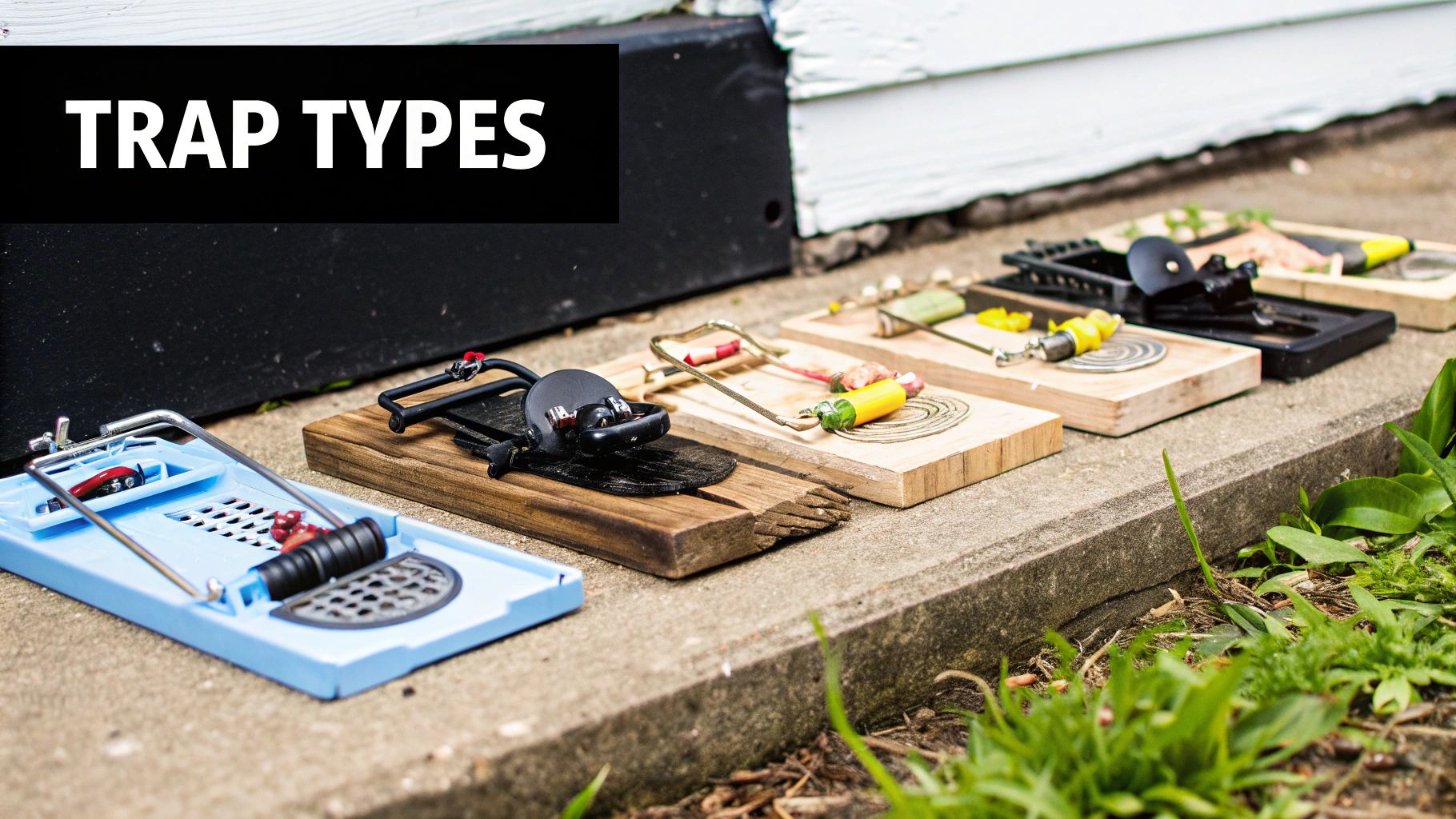
Knowing what draws rats to your property is half the battle won. The other half? Taking decisive action. This checklist pulls together everything we've discussed into a straightforward plan. Use it to give your property a thorough audit and start methodically removing the food, shelter, and access points that make it a target.
Remember, consistent prevention is your most powerful weapon. By turning these steps into regular habits, you can transform your home from an open invitation into a secure fortress that rodents will simply pass by.
Food and Waste Control
- Secure All Bins: Make sure every bin, inside and out, has a lid that fits snugly. For the best defence, switch to metal bins that rats can't chew through.
- Manage Pet Food: Don't leave pet food out overnight, ever. Store any dry pet food or birdseed in sealed, chew-proof containers made of metal or thick plastic.
- Clean Up Spills: Be vigilant about cleaning up any food spills, crumbs, or grease residue from floors, worktops, and outdoor patio areas immediately.
- Pantry Audit: Go through your cupboards and transfer dry goods like grains, pasta, and cereals from their flimsy cardboard or plastic packaging into airtight glass or metal jars.
It's worth remembering that a tiny, reliable food source is all a rat population needs to thrive. Cutting off their 24/7 buffet is the single most effective step you can take.
Sealing Entry Points
- Inspect Pipe Gaps: Check where pipes for water, gas, or electricity enter your home. Any gap wider than a pencil needs sealing with wire wool and a tough sealant or cement.
- Check Air Bricks: Look over all your air bricks for any signs of damage or decay. Fitting them with sturdy wire mesh covers will block access without stopping airflow.
- Examine the Roofline: Have a good look for gaps under roof tiles, damaged soffits, or holes in the eaves. These are common entry points for rats looking to get into your loft.
- Seal Foundation Cracks: Do a slow walk around the base of your property to spot and fill any cracks or holes in the foundation.
For a more detailed breakdown, our complete guide on how to prevent rats is packed with extra expert tips.
Outdoor and Garden Proofing
Keeping your garden tidy is a critical piece of the puzzle. By exploring effective garden pest control measures, you can make your entire property far less appealing to rodents.
- Clear Garden Debris: Get rid of piles of wood, old furniture, and general clutter. These are perfect hiding spots for rats.
- Maintain Vegetation: Keep your grass cut short and trim back any overgrown bushes, especially if they are right up against the house. This removes their cover.
- Secure Compost Bins: Make sure you're using a sealed compost bin. Critically, avoid adding any cooked food, meat, or fish scraps that create strong, inviting smells.
- Eliminate Water Sources: Fix leaky outdoor taps, tip out standing water from plant pots, and check your gutters are clear and draining properly.
Of course. Here is the rewritten section, crafted to sound like an experienced human expert, following the provided style guide and examples.
Common Questions About What Attracts Rats
Even with the best prevention plan, it's natural to have specific questions about rat behaviour. Getting clear answers helps you fine-tune your strategy, making sure you haven't missed a single detail in keeping your home rodent-free. Here are some of the most common queries we get from our clients, with straight-to-the-point answers.
Do Certain Smells Attract Rats?
Yes, absolutely. A rat’s sense of smell is incredibly powerful, and it’s their primary tool for sniffing out a meal. They’re particularly drawn to the scent of proteins and fats, which is why things like leftover meat scraps, pet food, or even a greasy bin bag are so irresistible to them.
An overflowing bin or an open compost heap is like a flashing neon sign for a hungry rat. While some people say rats dislike strong scents like peppermint oil, the promise of food will almost always win out. It's a far stronger motivator than any deterrent scent.
Can a Clean House Still Get Rats?
Without a doubt. While keeping your home clean and tidy definitely makes it less appealing, it doesn’t make it impenetrable. A spotless house can still get a rat problem if there’s a way for them to get inside.
Remember, a rat only needs a gap the size of a 10p coin to squeeze through. If they can find a tiny entry point and a food source—even just a forgotten bag of flour in the back of a cupboard—they will take advantage of it, no matter how clean the rest of the property is.
Are Rats Attracted to Water?
Yes, a reliable source of water is just as important to them as food. Rats will always be on the lookout for an easy drink, which is why they’re drawn to any standing water on your property.
This could be anything from a dripping outdoor tap or a pet’s water bowl to a bird bath or even clogged gutters collecting rainwater. Getting rid of these simple water sources is a crucial—and often overlooked—step in making your property a much less welcoming place for them to settle.
If you're dealing with a persistent rodent problem or just want a professional to secure your property, the experts at Pest Predators Limited are here to help. Our science-backed approach delivers solutions that last. Find out more at https://www.pestpredatorslimited.co.uk.

